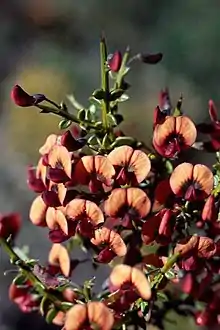Daviesia microphylla
Daviesia microphylla is a species of flowering plant in the family Fabaceae and is endemic to the south-west of Western Australia. It is an openly-branched, sprawling shrub with spiny branchlets, crowded, sharply-pointed, egg-shaped phyllodes, and orange, dark red and maroon flowers.
| Daviesia microphylla | |
|---|---|
 | |
| Near Beverley | |
| Scientific classification | |
| Kingdom: | Plantae |
| Clade: | Tracheophytes |
| Clade: | Angiosperms |
| Clade: | Eudicots |
| Clade: | Rosids |
| Order: | Fabales |
| Family: | Fabaceae |
| Subfamily: | Faboideae |
| Genus: | Daviesia |
| Species: | D. microphylla |
| Binomial name | |
| Daviesia microphylla | |
| Synonyms[1] | |
|
Daviesia parvifolia S.Moore | |
Description
Daviesia microphylla is an openly-branched, sprawling shrub, typically up to 0.6 m (2 ft 0 in) high and 1 m (3 ft 3 in) wide with sharply-ridged, spiny branchlets. Its phyllodes are crowded, partly overlapping, vertically flattened, egg-shaped and sharply pointed, mostly 2.5–5 mm (0.098–0.197 in) long and 1–2 mm (0.039–0.079 in) wide. The flowers are arranged singly in leaf axils on a peduncle mostly 3.5–4.5 mm (0.14–0.18 in) long with bracts 0.5–1 mm (0.020–0.039 in) long at the base. The sepals are 2.5–3.0 mm (0.098–0.118 in) long and joined at the base, the two upper lobes joined for most of their length, the three lower lobes triangular and up to 0.5 mm (0.020 in) long. The standard petal is broadly egg-shaped with a notched tip, 8–9 mm (0.31–0.35 in) long and orange with a dark red sentre, the wings 8.0–8.5 mm (0.31–0.33 in) long and maroon, and the keel about 8.0–8.5 mm (0.31–0.33 in) long and maroon. Flowering occurs from June to August and the fruit is an inflated, triangular pod 11–14 mm (0.43–0.55 in) long.[2][3]
Taxonomy and naming
Daviesia microphylla was first formally described in 1864 by George Bentham in Flora Australiensis from specimens collected by James Drummond.[4][5] The specific epithet (microphylla) means "small-leaved", referring to the phyllodes.[6]
Distribution and habitat
This daviesia grows in woodland or low heath and is found in the eastern Darling Range, but had a more extensive range in the past.[2][3]
Conservation status
Daviesia microphylla is listed as "not threatened" by the Department of Biodiversity, Conservation and Attractions.[3]
References
- "Daviesia microphylla". Australian Plant Census. Retrieved 16 February 2022.
- Crisp, Michael D.; Cayzer, Lindy; Chandler, Gregory T.; Cook, Lyn G. (2017). "A monograph of Daviesia (Mirbelieae, Faboideae, Fabaceae)". Phytotaxa. 300 (1): 263–265. doi:10.11646/phytotaxa.300.1.1.
- "Daviesia microphylla". FloraBase. Western Australian Government Department of Biodiversity, Conservation and Attractions.
- "Daviesia microphylla". APNI. Retrieved 16 February 2022.
- Bentham, George; von Mueller, Ferdinand (1864). Flora Australiensis. London: Lovell Reeve & Co. p. 86. Retrieved 16 February 2022.
- Sharr, Francis Aubi; George, Alex (2019). Western Australian Plant Names and Their Meanings (3rd ed.). Kardinya, WA: Four Gables Press. p. 252. ISBN 9780958034180.